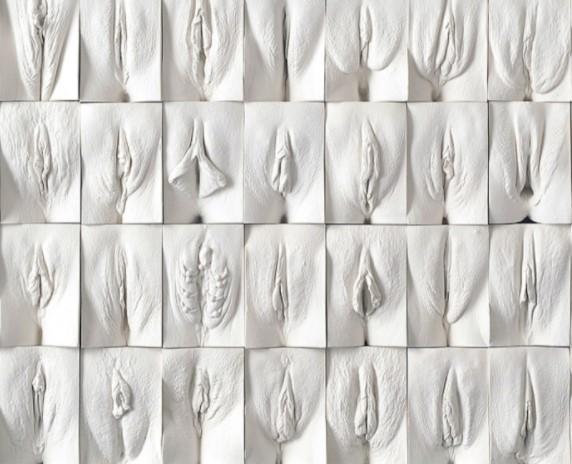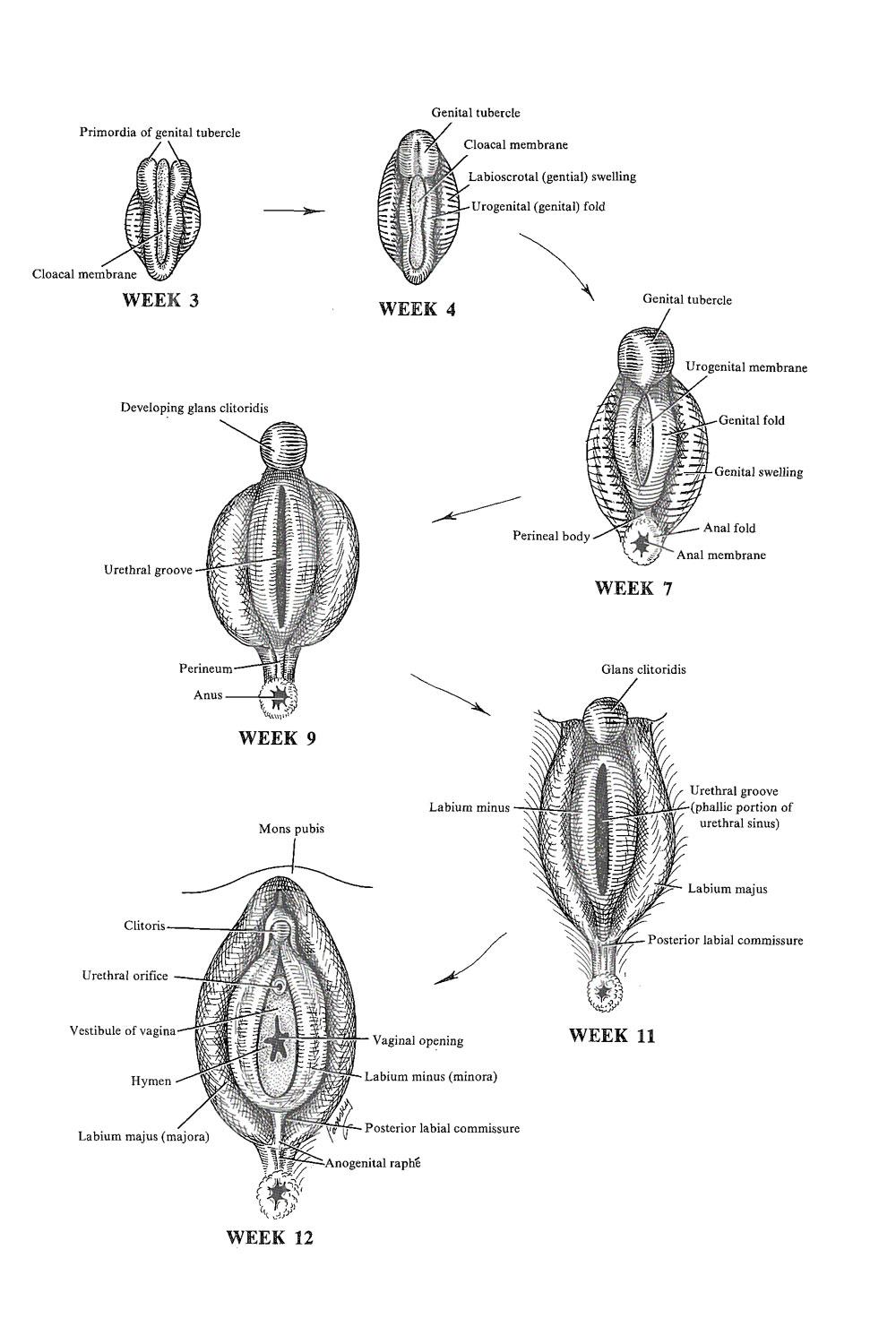
Labia
n., singular: labium
[ˈleɪbɪə]
Definition: Latin for “lips”; any bodily structure that is lip-like, such as the skin folds bordering the vulva and the lower petal of a labiate flower
Table of Contents
Labia Definition
Often, when persons think of the female reproductive system, they think of the vagina. However, the female reproductive system is made out of numerous inner and outer parts, including the labia. To define labia, we must think of its meaning.
The word ‘labia’ in this sense is in plural form (not labias) and the singular form is ‘labium‘. Labia is Latin for lips, and it is named so because labia in a human organism are the lip-like outer skin at the vaginal entrance. Typically, the labia majora (outer labia or lips) are plump and covered in pubic hair. The labia minora structure (inner labia or lips) is located next to labia majora. They start at the clitoris and end under the vaginal entrance and together make up the entire vulva. These can be seen in Figure 1 below.

Everyone’s labia will be unique as there are many different types of labia. The outie and innie vagina refers to how the labia length is. The length of the vagina labia determines whether someone has an innie or outie vagina. What is an outie vagina? A very long labia is an indication of an outie vagina and a short labia is an innie vagina. There are also different appearances in the color of the labia. There are dark labia, light labia, and some that are two-toned as well.
Anatomy
The labia majora from the lateral limits of the pudendal cleft, which also includes the labia minora, interlabial sulci, clitoral hood, clitoral glans, frenulum clitoridis, Hart’s Line, and the vulval vestibule, which houses the external apertures of the urethra and vagina.
Each labium majus has two surfaces: one that is pigmented and covered with pubic hair, and one that is smooth and riddled with enormous sebaceous follicles. Squamous epithelium covers the labia majora. There is a significant amount of areolar tissue, fat, and tissue like the dartos tunic of the scrotum between the two, as well as arteries, nerves, and glands.
The labia minora extend obliquely downward, laterally, and backward from the clitoris, finishing between the bottom of the vulval vestibule and the labia majora. The labia minora’s posterior ends (bottom) are normally linked across the middle line by a flap of skin known as the frenulum of labia minora or fourchette.
On the front, each lip splits into two sections that enclose the clitoris. The upper section of one lip goes over the clitoris and meets the upper part of the other lip, which may be somewhat bigger or smaller, producing a fold that overhangs the glans clitoridis (clitoral tip or head); this fold is known as the clitoral hood.
Diversity
Labias occur in a variety of forms, sizes, and colors. They even have distinct odors. Many people are concerned that their genitalia does not appear “natural” although there is no such thing. The only “normal” out there is what one considers to be normal. Both pairs of labia are commonly darker than the surrounding skin. However, there is no such thing as an average labia color. Pink or purple labia are more common in certain persons, whereas reddish or brown labia are more common in others.
Even if someone’s labia resemble a common “type” they will most likely have differences that distinguish them from the next person’s. Some labia contain traits that are shared by numerous kinds and cannot be classified into a single group. There are asymmetrical inner lips, curved outer lips, prominent inner or outer lips, and long, dangling inner or outer lips. Persons may have a combination of any of these or even something different. Different labia shapes can be seen in Figure 2 below.

Embryonic development and homology
The vulva develops in the fourth embryonic week when the proliferation of the mesodermal stroma close to the cloaca causes the elevation of the overlying ectoderm. This culminates in the creation of the genital tubercle, which will eventually become the clitoris, while two parallel ridges, each with a medial and lateral fold, grow laterally. The labia minora grow from the medial folds, also known as urogenital folds. The labia majora develops from the lateral folds, also known as labioscrotal folds.
The urorectal septum and the cloacal plate join towards the end of the sixth week of development to produce the urogenital membrane anteriorly and the anal membrane posteriorly.
The perineum is formed by the fusion of the lower portion of the labioscrotal folds anterior to the anal fold. Thus, the labia majora, labia minora, and clitoris epithelia are ectodermal in origin.
The mons pubis is formed when the bilateral labioscrotal folds unite prior to the genital tubercle. The formation of the vulvar vestibule, which is visible by the sixth week, originates from the confluence of the distal vagina and the urogenital sinus. The vestibule is endodermal in origin, with the exception of a tiny portion directly prior to the urethra, which may be of ectodermal origin.
The junction of the epithelium-derived from endoderm and the epithelium-derived from ectoderm is visible in adults on the inner aspects of the labia majora and is distinguished by the presence of sebaceous glands underlying the epithelium-derived from ectoderm visible on the medial aspects of the labia majora. The Bartholin gland, the vestibule’s main gland, is endodermal in origin.

Changes over time
The vulva’s appearance and even its shape naturally vary throughout time. The most noticeable alterations are associated with hormonal changes that occur throughout puberty, the menstrual cycle, pregnancy, and around menopause. Since of the journey through the birth canal and the action of maternal hormones, the labia may be somewhat enlarged during birth. For normal newborn female labia, which are thin and tiny, this fades within a few days.
The labia progressively get larger and thicker during adolescence, but the main difference is in keratinization, which changes at the cellular level. The labia become more noticeable during puberty as their prominence grows. As a woman grows older, her labial thickness and length increase, as does the thickness and length following pregnancy and delivery.
Since ovarian activity quits after menopause, the amount of female hormones such as estrogen and progesterone in the blood decreases. Skin tissue begins to waste away all over the body. The skin loses its barrier function and becomes dry. There is an increased risk of chemical and irritant dermatitis as a result of reduced skin thickness and moisture.
Sexual Arousal and Response
During this phase, there is an increase in the watery secretion, which causes improved lubrication. This increase in secretion is induced by vaginal wall constriction, as well as congestion and engorgement of the vaginal walls. Watery secretion seeps in when blood pooling increases, and this collects in the vagina and flows out into the vulva.
The labia majora widens apart and flattens during this phase, exposing the clitoris. The clitoris grows in size as a result. Unlike the excitement phase in males, these alterations may not be immediately visible. During this stage, blood artery congestion causes swelling of the vaginal walls. As a result, the vaginal aperture is reduced to around one-third of its former size. As the clitoris grows larger, it begins to stand upright and is hidden by the hood.
The thickness of the labia minora increases significantly, typically two to three times. This causes the labia minora to spread and the vaginal aperture to open. Because of blood vessel engorgement, the color of the labia minora changes from pink to red in White Caucasian women who have never had children. The hue shifts from red to dark red among women who have had a child before.
“Labia” in Other Biological Fields
The term ‘labia’ is not only confined to human anatomy. It is also used in other biological fields, such as botany and entomology.
Labia in botany
In botany, labium (plural: labia) refers to the modified petal of orchids and labiate flowers. The labium (also referred to as the labellum, plural: labella) is used in attracting insect pollinators. It serves as a landing platform for them.

Another plant family known for their labia is the Lamiaceae (or Labiatae). This family includes popular herbs in culinary (e.g., basil, mint, rosemary, thyme, oregano, etc.). One of their distinctive characteristics is their flowers with petals fused into upper and lower lips (thus, the alternative family name, Labiatae).

Labia in entomology
In insect taxonomy, Labia is a genus of earwigs. (See Figure 5) In insect anatomy, labium (plural: labia) pertains to the mouthparts of insects. The other parts are labrum, mandible, maxilla, and hypopharynx. (See Figure 6) The labium though is a single structure. Nevertheless, it is formed when two secondary maxillae fuse. Together with the maxillae, the labium assists in food manipulation during “chewing”.
 |  |
| Figure 5: Labia minor (a genus of earwigs). | Figure 6: Mouthparts of an insect: labrum (lr), mandibles (md), maxillae (mx), hypopharynx (hp), and labium (lb). |
The term “labia” (singular: ‘labium’) refers to any structure that is lip-like. In Latin, the term is used to refer to the “lips”. In human anatomy, there are two pairs of labia (lips) at the entrance to the vagina. They are the labia majora (the larger outside pair) and the labia minora (the smaller inside pair). Together they form part of the vulva (the female external genitalia). In botany, labium refers to specialized petals of certain plants, such as those of families Labiatae and Orchidaceae. In entomology, Labia is a genus of earwigs in the family Labiidae. In arthropods, the labium is the insect’s mouthpart, particularly the paired, fused secondary maxillae.
Try to answer the quiz below to check what you have learned so far about labia.
Reference
- Are My Labia Normal? (2018, June 6). Healthline. https://www.healthline.com/health/womens-health/lopsided-vagina
- Female Sexual Anatomy | Vulva, Vagina and Breasts. (n.d.). Retrieved March 13, 2022, from https://www.plannedparenthood.org/learn/health-and-wellness/sexual-and-reproductive-anatomy/what-are-parts-female-sexual-anatomy
- Gray, H., & Lewis, W. H. (1918). Anatomy of the human body. Philadelphia : Lea & Febiger. http://archive.org/details/anatomyofhumanbo1918gray
- Innie vs. outie vagina: What are the differences? Learn more here. (2021, February 18). https://www.medicalnewstoday.com/articles/innie-vs-outie-vagina
- Labia Changes with Age. (2017, October 17). News-Medical.Net. https://www.news-medical.net/health/Labia-Changes-with-Age.aspx
- Vulva Sexual Arousal. (2010, April 6). News-Medical.Net. https://www.news-medical.net/health/Vulva-Sexual-Arousal.aspx
©BiologyOnline.com. Content provided and moderated by Biology Online Editors.








